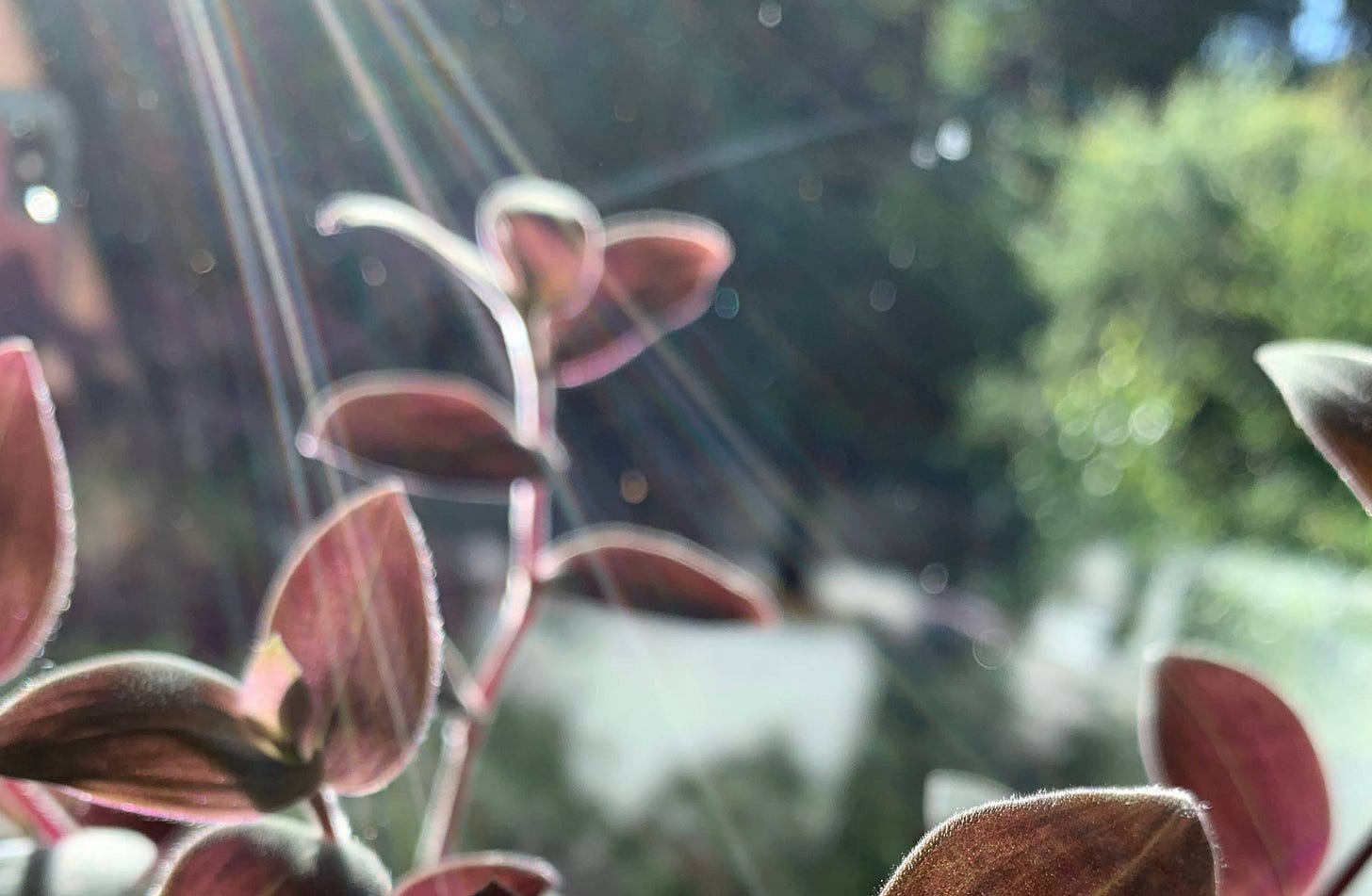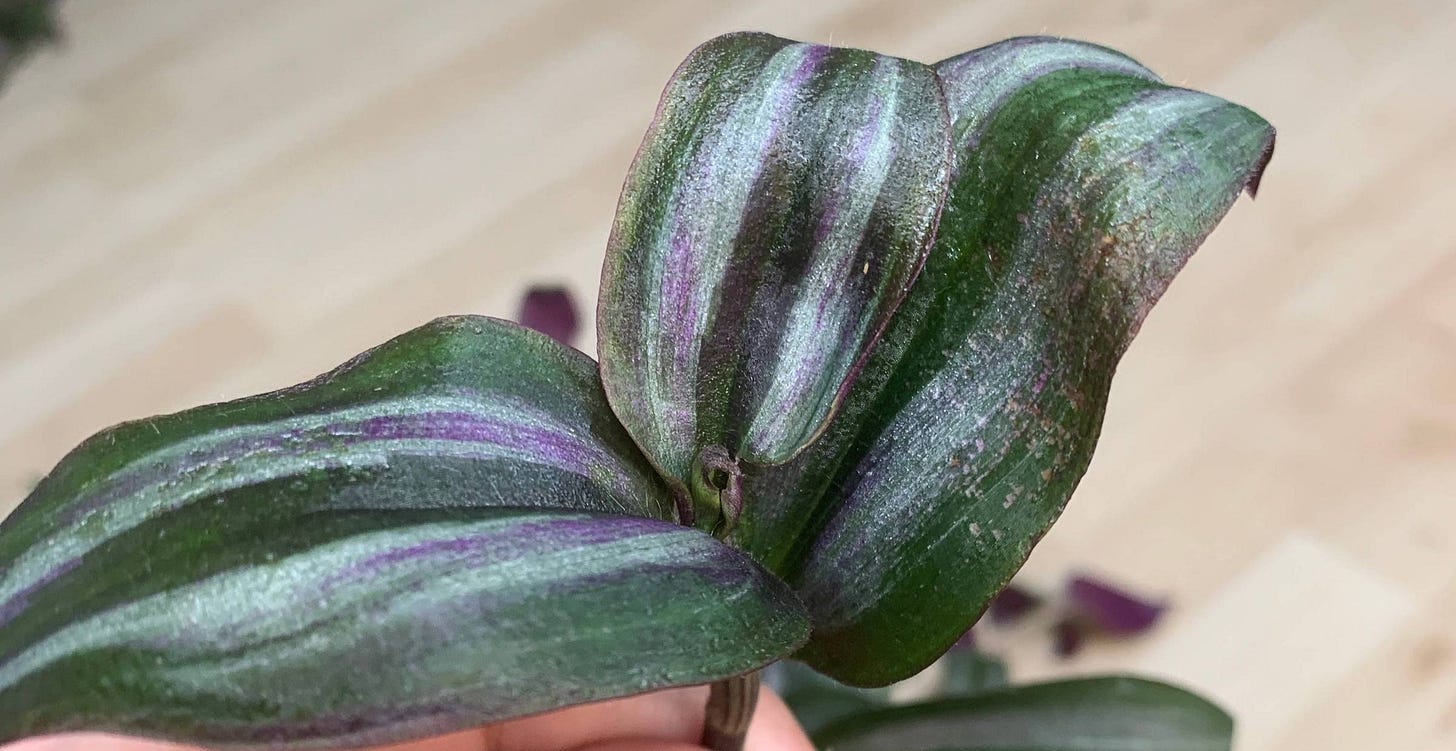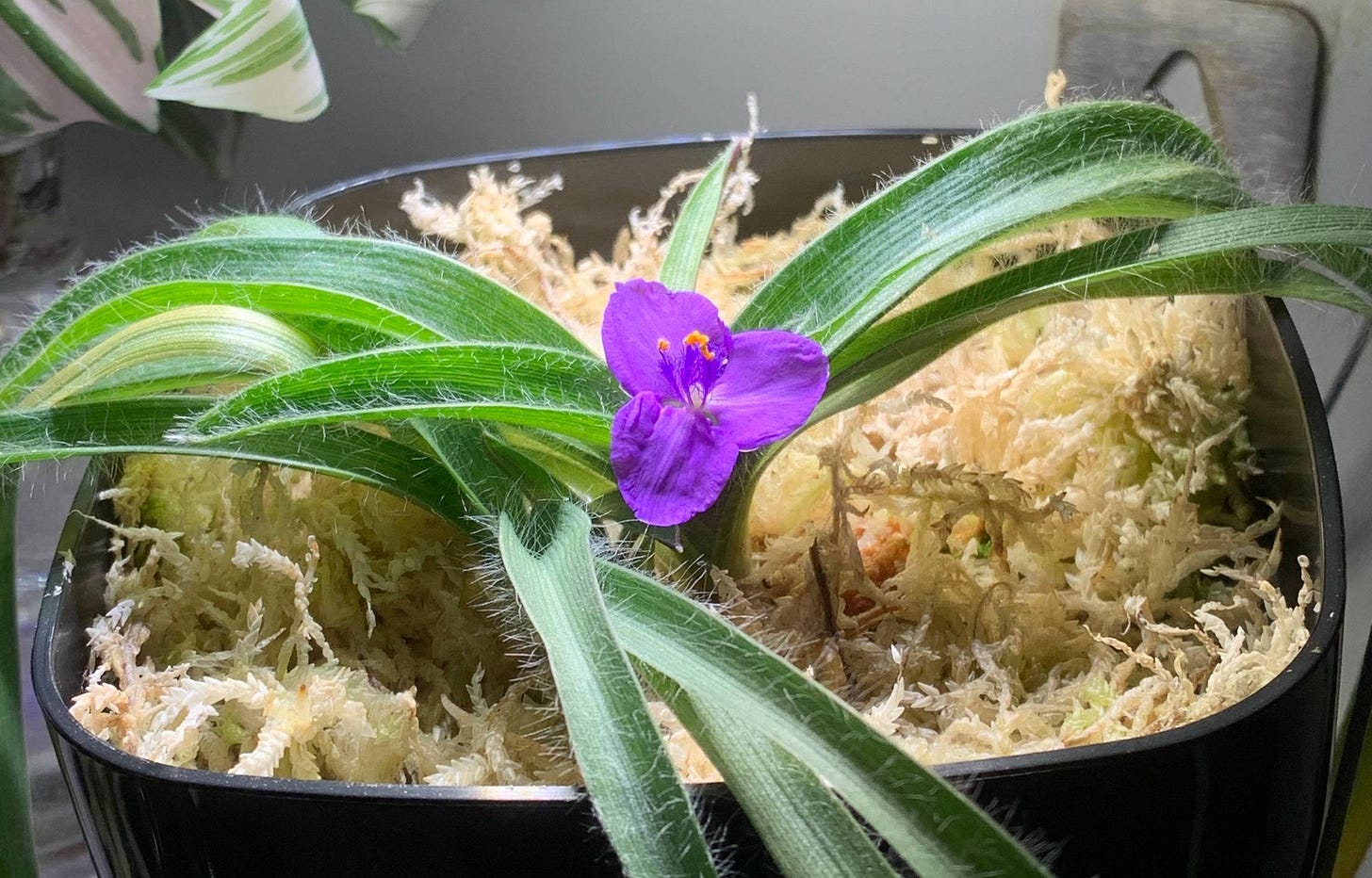5 Care tips to help Your Tradescantias Survive the Final Stretch of Winter
For our Tradescantias, winter isn’t always cheerful. The darker, colder months can be a real challenge for these plants. Maybe you’ve noticed pale leaves, leggy growth, or slower rooting. It can feel frustrating when your plants aren’t happy—but don’t worry, there’s hope!
In this week’s newsletter, I’ll share some simple tips to help your Tradescantias get through the last tough weeks of winter and bounce back strong when spring arrives. I’ll also introduce you to the lovely EC-TRADE-2011 (often called Sweetness), give you an update on how my winter storage experiment is going, and talk about whether the type of sphagnum moss you buy really makes a difference!
Tradescantia of the week: EC-TRADE-2011
Have you heard of EC-TRADE-2011? It’s not a name that one remembers easily, but you might know it as ‘Sweetness’ or ‘Feeling Flirty.’ EC-TRADE-2011 is the correct name for this cultivar, though it’s most commonly called ‘Sweetness.’
It’s part of the Continental Group, a collection of Tradescantias believed to be hybrids, known for its compact growth habit and relatively slow growth compared to other Tradescantias. ‘EC-TRADE-2011’ has small leaves, up to 5 cm long, and blooms with small white flowers.
‘EC-TRADE-2011’ is often mistaken for ‘Nanouk,’ though they really shouldn’t be hard to distinguish. ‘Nanouk’ has significantly larger leaves and a much thicker stem. Its variegation is also more pink, while ‘EC-TRADE-2011’ leans towards a lighter purple colour.
Care tips to help Your Tradescantias Survive the Final Stretch of Winter
Light:
Light is probably the most important factor for getting your Tradescantias through winter. Even the brightest window might not be enough during these darker months. Most of the time, they’ll do fine in bright windows—they might get a bit leggy and pale, but that’s easy to fix in spring by taking cuttings and starting fresh.
However, if they’re in darker spots, it can have a bigger impact on their health. If possible, use grow lights to give them a boost. Even a regular LED lamp can work as supplemental light. If grow lights aren’t an option, try rotating your plants so they can take turns in the brightest windows.
Watering:
In winter, it’s especially important to be cautious with watering. The lack of light can affect their health, making them weaker and more sensitive. This also means they need less water, and all of this increases the risk of root rot. Always check the soil before watering and make sure it’s completely dry first.
That said, there might be times when they need more water than usual, especially if the indoor air is very dry or they’re placed above a warm radiator. Keep an eye on them and adjust as needed!
Watch Out for Pests:
Weakened plants are more vulnerable to pests, and even though it’s winter, you might still find the occasional uninvited guest on your Tradescantias. A healthy plant is better at resisting pests, but during winter, when plants are often weaker due to less light and slower growth, they can become an easy target.
Keep an eye out for signs of pests, like discolored leaves, spots, or webbing, and act quickly if you notice anything suspicious. Prevention is key—regularly check your plants to stop any infestations before they get out of hand.
Hold Off on Fertilizing:
Unless you’re using extra grow lights and your Tradescantias are actively growing, there’s no need to fertilize during the winter months. Fertilizing now could encourage weak, leggy growth that struggles to support itself. Instead, wait until you see growth picking up naturally as the spring sun returns. Patience is key—your plants will thank you with stronger, healthier growth when the time is right!
Pruning, Propagation, and Managing Long, Weak Stems:
In general, it’s better to hold off on pruning and propagating during winter. Cuttings taken from an already weak plant are harder to root and more likely to rot. However, if your Tradescantia is growing long, leggy stems, it can be tempting to reach for the scissors.
If you do decide to trim, keep in mind that without providing the plant with more light, the new growth will likely also be long and leggy. So, if you can wait, it’s usually best to hold off until the brighter days of spring arrive.
Bonus: Do You Need to Increase Humidity?
There’s rarely any need to worry about humidity when it comes to Tradescantias. If your plant is struggling during the winter, it’s more likely due to one of the reasons mentioned above rather than low humidity. Tradescantias do just fine even in drier indoor air, as long as you’re keeping an eye on the key care points we’ve covered. Focus on light, watering, and general health, and your Tradescantia will thrive through winter without extra humidity!
Update: My Winter Storage Experiment
Three months ago, I shared my plan to try overwintering some of my Tradescantias in our storage room. With limited indoor space, I set up a shelf by a window in the storage room, which stays cold but above freezing. The goal was to see how well they could survive winter with minimal care.
So far, most of them are doing surprisingly well. They’re not growing much, which I didn’t expect anyway, but my Green Nanouk is even blooming. The only ones that haven’t made it are the Spathacea Dwarf and Pallida Ocampo White, but neither of them had any roots when I moved them there.
I’ve only watered once since October, and many of the plants don’t seem to need water again just yet. A few are starting to look thirsty, though, so I’ll likely give them a small drink soon. The biggest surprise? My Sillamontana still looks great.
This experiment has been such an interesting learning experience, and I can’t wait to see how they hold up as winter progresses.
Sphagnum Moss: Does It Matter Which One You Buy?
As I’ve mentioned before, I love using sphagnum moss for my Tradescantias. It’s great for propagation and even growing certain varieties long-term. But does the type of moss you buy really matter? The short answer is yes! Not all sphagnum moss is created equal, and the quality can have a big impact on your plants.
High-quality moss is light in colour, has long, clean strands, and minimal debris like sticks or grass. It lasts longer, holds moisture more evenly, and reduces the chances of mold or algae growth. Cheaper moss, on the other hand, tends to break down faster, compact more easily, and can even cause a pH imbalance in the soil.
Personally, I’ve learned this the hard way. After trying a cheaper moss, I noticed it got moldy and compacted much sooner than I expected. One big problem I had when using lower-quality moss was fungus gnats. The moss seemed to attract them much more, and dealing with an infestation was no fun! Since switching to better-quality moss, this hasn’t been as much of an issue.
Now, I stick to SYBotanicas Sphaxx, and it’s made a noticeable difference! (Use code: KATJA10 for 10% off your entire order!) They also have a great selection of soil mixes, my Tradescantias absolutely love their Ficus Mix, which I’ve been using for a while. If you’re looking for high-quality products for your plants, I highly recommend checking them out!
Disclaimer: This is an affiliate link, which means I earn a small commission if you make a purchase using my code, at no extra cost to you. Your support helps me keep sharing Tradescantia tips and content—thank you!
So, while it might be tempting to save a bit of money, investing in higher-quality sphagnum moss is worth it for healthier Tradescantias and fewer headaches.
Community Highlight
Do you have a Tradescantia collection? Or maybe one or two you’re especially proud of? Why not show it off in the next newsletter’s Community Highlight?
Reply to this email, email me at katja@exploringtradescantias.com, or send me a DM on Instagram—I’d love to feature your favorite plant!
Until next time, happy planting! 🌿
Katja







